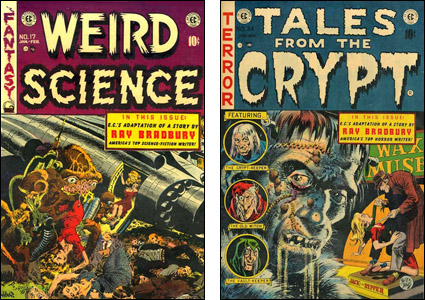
In the early fifties, EC Comics adapted a number of Ray Bradbury's short stories into comic book form with his permission. Before that, they adapted a number of them without his permission. The way most of their science-fiction, horror and crime comics were written was that publisher William M. Gaines would come up with what they called "springboards." A springboard was a rough plot and Gaines, who was not a writer but thought he knew a good story, would come up with dozens of them.
Some were original and some came from movies he'd seen, books he'd read, radio shows he'd listened to, etc. In other words, plagiarism. But it was usually that soft kind of plagiarism in which you take some, not all of the source material and you change it a lot and by the time it's completed, it isn't that much like the material you ripped-off. Sometimes though, it was more obvious.
Several days a week, Gaines's main editor-writer Al Feldstein would have to write a story for one of the comics he produced and Gaines would "pitch" springboard after springboard to Feldstein, hoping to interest Al in one of them. Al was fussy but he usually found one he liked and he'd go off and write it and then a fine artist like Jack Davis or Wally Wood would draw it. Once, he wrote one without realizing it was stolen from not one but two of Ray Bradbury's short stories. EC took "The Rocket Man" and "Kaleidoscope" and merged them into a story for Weird Fantasy #13 that wound up being called "Home to Stay."
Not long after its publication, the burglary was noticed by Mr. Bradbury but he did not go screaming to lawyers. He noted that the adaptation was well-done and that the two stories had been rather cleverly intertwined, the whole being greater than the sum of its parts, so to speak. Suing might cost a lot, he knew, and there probably wasn't much money to be collected…so he tried another approach. He wrote Gaines a letter that said, in essence, "You seem to have neglected to pay me for the adaptation of my work." Gaines sent a modest check, a brief correspondence ensued and EC wound up adapting many of Ray's stories on an official basis.
It was a mutually-beneficial relationship. Bradbury loved what they did with his work and he protected his copyrights and probably attracted some new readers to his books. EC got the prestige of his name on its covers. That seemed to boost sales a bit but it was probably more valuable that it gave EC a thin film of moral cover. The company was then under some volume of siege for the content of its comics and it helped a bit to tie their product in with Bradbury. He was, after all, a popular writer whose books were turning up in libraries and who had works in prestigious mainstream magazines. How could you dismiss EC's Tales from the Crypt as "trash" when one of its stories was being read in another form in schools? To say nothing of the fact that a lot of the non-Bradbury stories were not all that different in tone and taste from the Bradbury ones.
That didn't save EC's line from extinction, nor was it intended to. But Gaines thought it helped a little for a time.
During this period, Bradbury had little contact with Gaines and none whatsoever with Al Feldstein. When EC Comics ended in the mid-fifties, Feldstein and Bradbury had never met. They didn't meet in the sixties or the seventies or for the rest of that century.
In 2002, they finally met. It will probably take me three parts to tell this story but bear with me. It will be worth it.